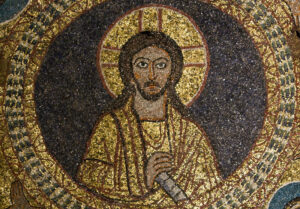“Jesus shows himself to be such precisely in the measure that he is present via those who are the absent, anonymous people of history — those who are not the controllers of history, namely, the mighty, the socially acceptable, ‘the wise and the learned.'” — Gustavo Gutiérrez, The God of Life
In Gustavo Gutiérrez’s beloved meditation on the poor in The God of Life, he tells us that if we long to grasp God’s revelation in Jesus, we must understand that God came into the world among the poor and conquered, rather than the powerful and unafflicted. Gutiérrez’s tradition of liberation theology forces us to reckon with a God who decisively takes sides with the poor. Seeing Christ as the poor person surviving imperial rule and gathering the “anonymous” of history is what enables us to image Christ today.
While many liberation theologians champion God’s preference to become the poor in Jesus, fewer pause to dwell on God’s preference to enter the world through the body of a poor, unmarried woman surviving empire. They are eager to get to the boy in the manger. But God did not suddenly materialize in that trough. God took their time, kicking and growing in a woman’s stomach.
I have to admit, I’ve never cared much for the character of Mary. She is boring. When I say this, people love to remind me that it is Mary who gave us the Magnificat, a revolutionary song that has been banned by multiple colonial governments for its radical theology. But the Mary I’ve been introduced to doesn’t seem capable of threatening anyone or anything — certainly not the rich or powerful. Every sermon I hear about Mary is determined to be as lovely as she, apparently, was. The most radical image she takes on is breastfeeding.
This Mary is a quiet, submissive woman, meekly pondering the mysteries of God. Always accepting, never questioning. I’m often told that Mary wasn’t passive or silenced, she just prefers to ponder what can’t be spoken, wisdom of such depth that ordinary language fails. When she does speak in the Magnificat, her words are inevitably spiritualized. But I don’t think we can understand the radical words of the Magnificat without taking the time to consider the concrete experiences that led her to ponder these words in the first place. This is the cry of a social prophet, a withering indictment of exploiters and oppressors, and an announcement of revolution. How could such a docile woman produce what Dietrich Bonhoeffer called “the most passionate, the wildest, one might even say the most revolutionary hymn ever sung?”
But Mary isn’t just boring. Mary has always frustrated me because she’s so unlike the real girls I know. She represents a contradiction so many women are forced to embody: they must be sexually untainted and innocent while fulfilling a role of motherhood and maternal wisdom that can only come through intimate sexual knowledge. Mary’s pristine, undesiring body, her humble acceptance of bearing the child of God — at the risk of death — sounds less like real life and more like the deferential qualities men prefer in women who want to participate in God’s work.
In her book Indecent Theology, the queer theologian Marcella Althaus-Reid poses a radical challenge to the obfuscation of Mary’s body. She says, “If it is true that the first inscriptions (of hunger, pain and sexual desire) are always written in the body, one wonders how a women’s theology can start with Mary, the icon of a no-body. To start with Mary is to start with an idea, a gas-like substance, a myth of a woman without a vagina which discloses in a hilarious way the fact that half of humanity has been constructed around ideas of ghostly simulacras … For me, if the Virgin Mary had paws instead of hands and her vagina was in her ear, thus making it easier for the Word of God, the Logos, to ‘say its Word’ and penetrate her, it would not make any theological difference. Mary is in the realm of the fantastic and phantasmagorical.”
For Christians committed to a theology of liberation, Althaus-Reid provokes the question: what would happen if we gave Mary her body back?
Last December, as I was quarantined and writing an Advent sermon, I received a text from a friend I hadn’t seen in years with a link to a news article. A childhood friend of ours had left her house for cigarettes at 1:00 am and went missing. Her body was found later near the woods. She had been stabbed more than 20 times, mostly in the head, neck, and stomach. She was 22 years old, and five months pregnant with her third child. Because her mother couldn’t afford a funeral, her cousin started a GoFundMe to cover the expenses. Soon, everyone was sharing this appalling story on social media with comments like: “The tragedy. I remember her!!” “We went to school together. Prayers for her kids.” “How could this happen in our community? Prayers.” “During Christmas time? Sending love.”
After reading the news and scrolling through these posts, I messaged another mutual friend from childhood to express my grief and check in. We had all gone to church together, but she had kept in touch more than I had. She messaged me back.
“I’m really disappointed that it happened the way it did. I don’t know if you’ve read any articles or not but they said her and her killer were participating in “dangerous acts” and that’s disappointing to me. It shouldn’t of happened regardless and it is in no way her fault. I just think it would be easier to accept if she wasn’t doing that, ya know?”
What most of the articles that first circulated left out was that my murdered friend had been working in the sex trade, responding to a customer the night she was murdered. I knew this would change things. An article that did report this information held different comments when shared. “She’s pregnant, smoking & going out to meet a super creepy guy in the middle of the night… and this isn’t her fault? Doesn’t sound like she made the best choices.” “She was an escort, that is just so dangerous ! Prayers for her kids!!!!” “Why is her pregnant ass meeting people online in first place it doesn’t cost nothing to take a min a think about what your doing this is sad”
“We can talk about torture and salvation, but not of vaginas and salvation.” — Marcella Althaus-Reid
What would happen if we gave Mary her body back?
Perhaps she would become real to us for the first time. We might remember that the unmarried Mary was smeared as illegitimate, a whore — hardly a sign of divine credibility or sexual purity. We might see that Mary was an indecent woman. We regularly image Mary as a poor, young girl — maybe an unmarried pregnant girl who is disbelieved — but never indecent. Always innocently ignorant, never a secret keeper. Not our Mary, no. She’s never desperate or demanding or addicted.
Without engaging Mary as indecent, our theology expresses a preference for the pornographic. Here, “pornographic” is not defined by what is taboo, arousing, or sexually explicit. Pornographic theology is the scripted behavior of bodies. Rather than beginning with ordinary people’s lived, queer experiences, pornographic theology ignores what’s “real,” endorsing posed acts of sexuality to create false norms. These posed sexual norms and gendered scripts are continually marketed back to people as correct moral performance. But the pornographic isn’t attainable because it isn’t real. The pornographic is sexual-political ideology. It is patriarchal-sexual fiction. In Mary’s case, it permits the fetishization of the spiritual over the material — her real body swapped for a theological abstraction that fulfills patriarchal-sexual fantasies of feminine holiness and submission. It flies in the face of the incarnation, which as Althaus-Reid says, undoes this preference of spiritual over material and transgresses them both.
Althaus-Reid criticized liberation theology’s own tendency to become pornographic when it imagines the poor as an undifferentiated population centered around heterosexist norms of gender, family, and economy. “[P]oor people are presented in the Theology of Liberation as decent, that is, asexual or monogamous heterosexual spouses united in the holy sacrament of marriage, people of faith and struggle who do not masturbate, have lustful thoughts at prayer times, cross-dress, or enjoy leather practices. However, if we keep falsifying human relationships in the name not only of God (a habit to which we have grown accustomed) we must remember that we do it also in our love for justice.”
Obscuring Mary’s indecency, reducing her to a sexless, “ghostly simulacra” is a refusal to engage the preference for the poor. To properly understand the poor and be in solidarity with them, we need to see the poor as they are: not only politically concerned, but political in gendered, queer, and indecent ways. Pornographic theology allows the gendered and sexed realities of poverty to go unexamined, authorizing ideological scripts of decency that dominate the lives of poor women (particularly mothers) and queer people. But, with Althaus-Reid , we must begin with their embodied experiences of gender, sex, and queer desire: to evacuate these experiences from our theology essentializes — and thereby sanctifies — the horrors of poverty.
I do not say we must know the poor as queer and indecent in order to essentialize these identities. I do not say we must know Mary as indecent in order to endorse the liberal feminist notion of empowerment through sex-positivity. And in telling my friend’s story, I am not lauding sex work as inherently liberating for poor women — a trap that sacralizes poverty. I say these things to call our attention to the real economies that real women participate in to survive in the real world. I say this to remind us of the real people through whom God chooses to reveal themselves.
What would happen if we gave Mary her body back?
We might recognize that the limits we place on Mary’s embodiment are the same limits we place on God. Perhaps we would see that our ability to imagine Mary’s indecency directly corresponds to our imagination of God’s limits — the limits of who God will use, where God will appear, and who gets to define God’s primary concerns.
We would be compelled to practice what Althaus-Reid called Indecent theology. “Indecenting” requires unfaithfulness to ideologies — especially heterosexist ideologies that serve economic interests — and demands honesty and faithfulness to God. Just as God in the incarnation set aside the scripts of divinity as glory, power, and empire in order to live among the poor, indecenting sets aside the ideological to focus on the “real”. Indecent theology enables us to recognize incarnational insights from Mary that have been silenced, and image Christ today without heterosexist scripts.
Someone recently asked me why I care so much about the “real” Mary and what on earth she has to do with my leftist politics. My first answer is that as long as the gendered nature of poverty goes unexamined, the poor, indecent women who would be Mary today cannot see themselves as “highly favored” by God; they will be vulnerable to ideological scripts of holiness, degraded and discarded. Mary’s story is also important because, as the incarnation teaches us, everything we do happens first through the body. To give Mary her body back will provoke troubling questions of consent — questions that cannot arise for a “decent” theology. We will have to deal with a God choosing and impregnating a real woman’s body and the depictions of God as potentially violent and violating. But we must first give Mary’s body back to her, even as those questions arise. The conquest of Mary’s body — and the bodies of all women — lingers in the Advent story so long as Mary remains the phantasmagorical character, the untainted, ever-consenting virgin.
I care about the embodied Mary because the same sexist ideology that makes her a “no-body” also left those who loved my friend mourning in silence and shame. I care because God wasn’t seen in my dead friend — and still isn’t. I don’t want to ponder what happened to her in my heart. It was revelatory but not precious. It was terrifying and unjust, an indecent act that is unnervingly routine and real.
Ultimately, I care because I’ve always ignored Her and when I finally recognized Her it was too late. No angel came down this time to stop her death sentence. No angel declared that God chose her to teach Christ how to love. She should be protected at all costs.
I returned to my Advent sermon with a mixture of fury and disgust. I tried to write about the coming of Christ, but I couldn’t see him. It struck me that we are routinely encouraged in this season to see Christ as the poor, naked, incarcerated, hungry, and homeless — but usually a heterosexual man who is poor, naked, incarcerated, hungry, and homeless. To push back against this tendency, some progressive Christians have attempted to make Christ gender-neutral But I am no longer interested in making the incarnation gender-neutral, because poverty and premature death are not gender-neutral. I am interested in what it implies for a woman to be poor and naked and incarcerated; and why is it different? What does it mean for a queer person to experience the pangs of hunger or go without a home? I want the specifics.
When we retell the Advent story with idealized, ethereal images of Mary, we participate in pornographic theology. We mutilate her real body. When we forget Mary would have been perceived as a slut, we lose the particularities of the people God chooses. Claiming she was the mother of the messiah would have made her an ignorant, arrogant bitch. If Jesus came today — and Jesus does — no one would think their mother was a good woman, much less worthy of teaching God how to talk, walk, and pray.
The boy in the manger continued God’s project by going to the people and places that were seen as indecent and sinful. Jesus will let those deemed whores touch his feet in public and anoint him with oil, rubbing away the dirt between his toes with their hair. I wonder if he thought of his mother in those moments. When he put his finger in the dirt, did he know that this woman dragged before men and the law could have been his mother, Mary, disbelieved and killed? It would have been considered a just death. People like to think Jesus wrote out the sins of the crowd one by one, but I wonder if he wrote down something Mary taught him.
We love to think we would have recognized prophets in their time. Jesus gave us a metric for this. How do you see the least of these, those right in front of you? The sex worker, the whore? How do you treat the single mother who lives in the poor neighborhood in your hometown?
Brooke Matejka (she/her) is a Master of Divinity and Master of Arts in Christian Education student at Princeton Theological Seminary. She is the moderator of the student group Seminarians for Peace and Justice, which works to divest the seminary’s endowment from the prison and military-industrial complex.
Artwork: “Modern Mother Mary.” Ernesto Ybarra, 2020




